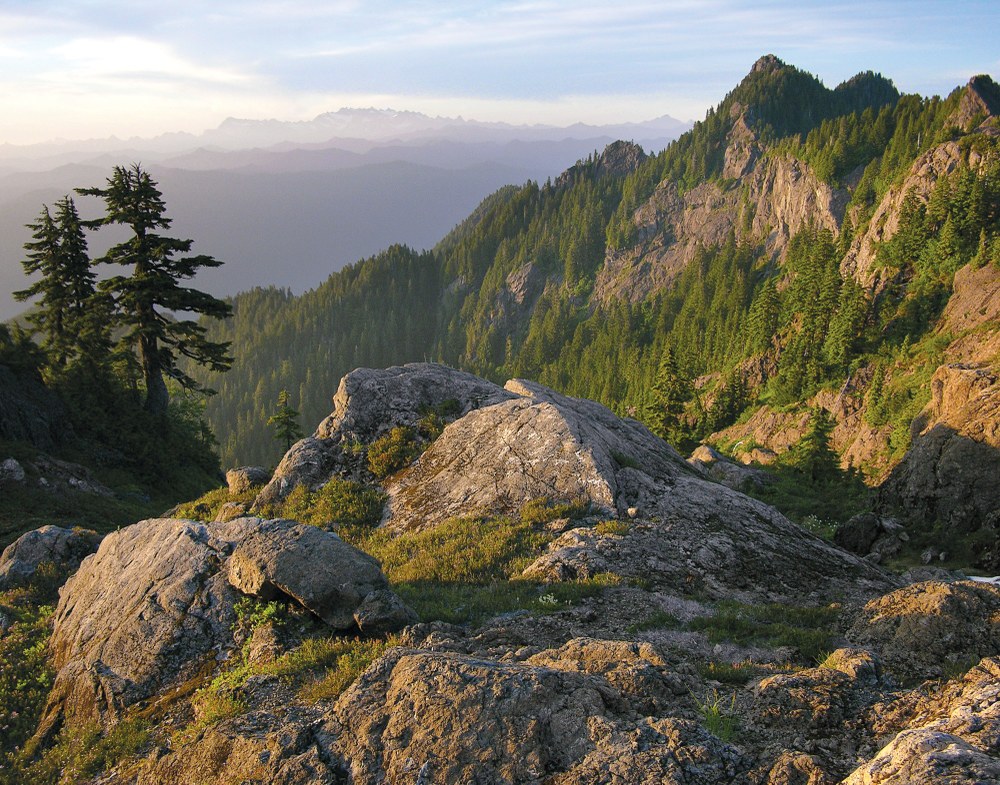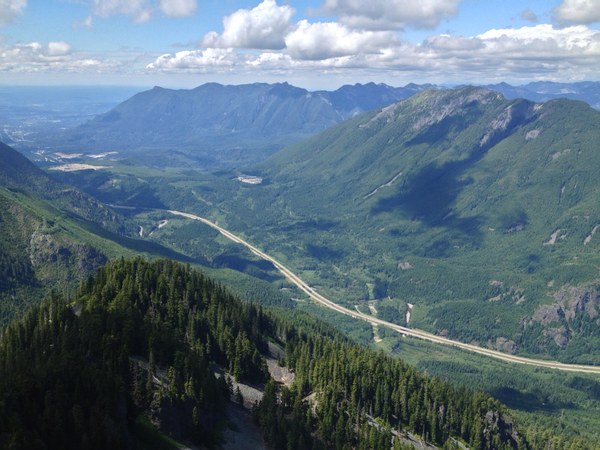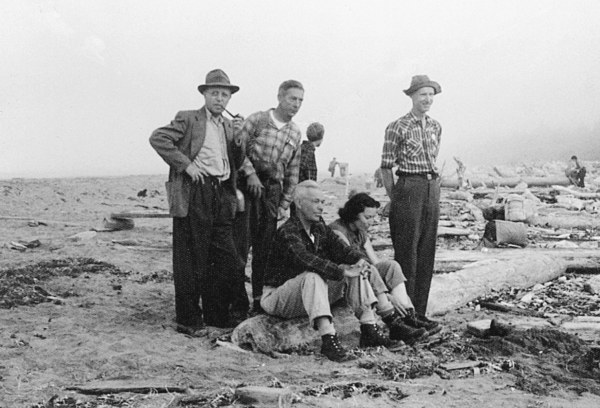
When you hear the word “conservation,” what comes to mind? To us, conservation can mean protecting natural landscapes for public enjoyment through the creation of national parks, forests, and wilderness areas. It can also mean individual acts of advocacy, stewardship, or low-impact recreation.
Conservation has been an enduring priority for The Mountaineers since our founding. Our community deeply believes in adventuring with purpose, with the goal of protecting the natural landscapes that make our adventures possible. Without conserved public lands and waters and recreational access to these places, The Mountaineers and the opportunities we provide would cease to exist.
Why do We Adventure With Purpose?
Since our organization’s founding in 1906, early members recognized the importance of protecting natural landscapes so that they can endure into the future. Conservation was a central tenet of The Mountaineers first constitution, which set out to “preserve by the encouragement of protective legislation and otherwise the natural beauty of the Northwest coast of America.”
Conservation is, and always has been, one of our deepest held values. Since our inception, exploitation, destruction, and neglect threatened the region’s natural landscapes, inspiring passionate Mountaineers to protect outdoor spaces. Those early conservation efforts - which led to many monumental victories - and the courageous people behind them, are woven tightly into the history of our organization and the broader conservation movement in Washington State.
By educating our members about conservation principles like low-impact recreation and encouraging participation in stewardship and advocacy activities, we continue to support recreationists from across our branches and activities as stewards and advocates. Together, we’re striving for a better future for our public lands, communities, and climate.
Conservation Through the Years
From the formation of Olympic National Park in 1938 to the recent expansion of the Alpine Lakes Wilderness in 2014, The Mountaineers has played a role in nearly every major public lands conservation campaign in our state's history. Our members also helped secure many landmark national conservation victories, including the passage of the Wilderness Act in 1964 and the Great American Outdoors Act in 2020. Time and again, recreationists sharing their connection to the outdoors have helped convince elected officials and land managers to protect special places.
While we’re proud of this 116 year history of advocating for the protection of natural landscapes, we recognize that much of that work was not done in collaboration or consultation with local Native tribes. Most of those efforts did not acknowledge that the places we sought to protect are Native lands, and tribes have deep cultural and legally-protected connections to the lands. As a result, Native stories are largely missing from both historical and contemporary narratives of The Mountaineers and our legacy - something we are still grappling with today. We are committed to elevating the cultural history and traditions of Indigenous peoples who have carefully stewarded the lands and waters of the Pacific Northwest for many thousands of years.
Protecting Olympic National Park
The protection of the forests, mountains, and coastlines of the Olympic Peninsula as a national park is one of the earliest examples of The Mountaineers involvement in a large-scale land protection campaign. By the time The Mountaineers was formed in 1906, an astonishing amount of the Northwest’s old growth forests had already been cut down.
Along with the Sierra Club and the Mazamas, The Mountaineers helped popularize the idea of wilderness preservation on the Olympic Coast through annual outings drawing thousands of people. These and other efforts by the groups helped turn public support away from commercial exploitation of the area, and towards recreation and preservation.
Despite National Monument Designation in 1909, there was an ongoing need to go even further to protect the peninsula’s wild places and oppose industry efforts to roll back protections. Mountaineers members kept up advocacy efforts until Olympic National Park was established in 1938.
The Mountaineers continues to build on this legacy by advocating for increased wilderness protections through the Wild Olympics campaign. You can read more about The Mountaineers historical efforts to protect Olympic National Park in this blog post.
Image of Mountaineers on a 1958 hike to gain publicity to protect one of the last remaining roadless areas on the Pacific Coast Beach.
The Passage of the Wilderness Act
Beyond fighting to preserve key landscapes throughout Washington, Mountaineers members also helped build a groundswell of support for bedrock federal conservation laws like the Wilderness Act of 1964. The Mountaineers helped organize a series of Northwest Wilderness Conferences that popularized the idea of designated wilderness on the national stage.
The passage of the Act changed the national conservation landscape forever. It helped preserve the Northwest’s wild places for future generations, including Glacier Peak Wilderness and North Cascades National Park.
North Cascades National Park
In 1968, The Mountaineers celebrated the creation of North Cascades National Park - the result of decades of advocacy by our members and the broader conservation community. Our Everett Branch recommended the creation of a national park in the North Cascades in 1936, and led early efforts to increase public awareness of the idea.
In the 1950s, members partnered with other conservation groups like the Sierra Club and became heavily involved in the park’s publicity campaign. Mountaineers members also helped start the North Cascades Conservation Council (NCCC) - a group that proved instrumental in the effort to create the park. Mountaineers Member Phillip Zalesky, the first president of the NCCC, helped spearhead this effort.
The campaign to protect the North Cascades also represents one of the first convergences of The Mountaineers grassroots advocacy and book publishing efforts on behalf of public lands. One of the club’s early publications, Harvey Manning’s The North Cascades, was a focal point of this campaign.
Securing this important victory for wild places and backcountry recreation in our region has allowed Mountaineers and the broader recreation community to experience the magic of our local glaciers, alpine lakes, rivers, and beyond.
The Alpine Lakes Wilderness
The Mountaineers were instrumental in preserving the Alpine Lakes area of the central Cascades as Wilderness. In another case of a Mountaineers book playing a critical role in a land preservation campaign, photographs from The Alpine Lakes (1971) inspired President Gerald Ford to protect the Alpine Lakes as a Wilderness Area.
After a dedicated advocacy push - which included presenting copies of the book to every member of the Senate committee - President Gerald Ford was under pressure from big business to veto the bill. Washington Governor Dan Evans, a champion of Washington’s wild places, carried the bill through the final stretch by meeting with the President. After sharing the book’s stunning photos and discussing the importance of the area, President Ford signed the bill creating the Alpine Lakes Wilderness Area. You can read more about the book that saved the Alpine Lakes in this blog post.
Given its close proximity to Seattle, the protected peaks, ridgelines, valleys, and watersheds of the Alpine Lakes allow many recreationists to experience wilderness closer to home. More recent Mountaineers advocacy led to new protections for the Alpine Lakes through expansion of the Wilderness Area in 2014.
Washington’s State Park System
The pioneering conservation efforts of The Mountaineers aren’t limited to federal land protections. We also played an instrumental role in the creation of Washington’s state park system. Early member and former Seattle Mayor Robert Moran first attempted to donate land on Orcas Island to Washington State in 1911, a time in which there was great conflict over whether the state should manage areas for recreation and public use. In 1921, longtime Mountaineers Vice President Edward Allen helped persuade the newly-formed Washington State Park Board to accept the donated land for what is known today as Moran State Park. Washington’s first major state park led to the development of the state park system, which hosts Mountaineers activities and programs each year.
Continuing our Conservation Legacy Today
The climate crisis, increasing outdoor recreation, and development bring new and emerging threats to our public lands and waters, underscoring the need for increased protections and funding. Despite these challenges, our community continues to adapt and respond to these challenges to protect the parks, trails, and waterways we cherish.
Conserving the Methow Headwaters and the Mountains to Sound Greenway
Several years of advocating to protect the headwaters of the Methow River from industrial-scale mining and conserving the Mountains to Sound Greenway as a National Heritage Area culminated in the passage of the 2019 federal public lands package. Leaders of Washington’s congressional delegation championed these bills, thanks in part to letters by and legislator meetings with The Mountaineers and our conservation and recreation partners. This law will ensure that the landscapes of the Methow Valley and Greenway Heritage Area, and the recreation opportunities they provide, will remain protected into the future.
 Image of the Mountains to Sound Greenway. Photo by The Greenway Trust.
Image of the Mountains to Sound Greenway. Photo by The Greenway Trust.
The Great American Outdoors Act
After years of advocacy by Mountaineers members, we celebrated the passage of the Great American Outdoors Act (GAOA) in 2020. The GAOA provides full and permanent funding for the Land and Water Conservation Fund (LWCF) and five years of funding to maintain and restore parks and public lands by addressing the maintenance backlog. GAOA funding is already being put to use to address maintenance issues at Mount Rainier National Park, the Mount Baker-Snoqualmie and Okanogan-Wenatchee National Forests, and other public lands throughout the region.
Braided River: Inspiring Conservation Action
As you can tell, Mountaineers Books has been an important piece of our conservation story. Since the 1960s, our titles have influenced the creation of national parks and protected wilderness areas through images and stories.
For the last 15 years, Braided River, the conservation imprint of Mountaineers Books, has worked with photographers, authors, and conservation partners to tell visual stories that inspire a wide audience to protect our communities, lands, and wildlife. Braided River’s Arctic National Wildlife Refuge: Seasons of Life and Land was credited with influencing the Senate’s historic vote to save the Arctic Refuge (ANWR) from energy development in 2003.
Be a Part our Conservation Story
Grow your involvement in conservation and advocacy and help conserve public lands and the outdoor experience by connecting to our conservation education, stewardship, and advocacy opportunities. The Mountaineers conservation education resources will help you lessen your impact on the landscape and better advocate for our public lands. We encourage you to give back to our special outdoor places through participation in stewardship activities. And don’t forget our Conservation Currents newsletter - it’s the best way to receive blog posts, action alerts, land manager surveys, and other ways you can help shape the future of our public lands.
Learn more about Mountaineers conservation history in Jim Kjeldsen’s The Mountaineers: A History and on our conservation victories page. Look out for future stories in our Conservation 101 blog series to help you unpack the world of conservation and advocacy. In case you missed it, check out the initial posts in this series on advocacy and public lands.
 The Mountaineers
The Mountaineers
